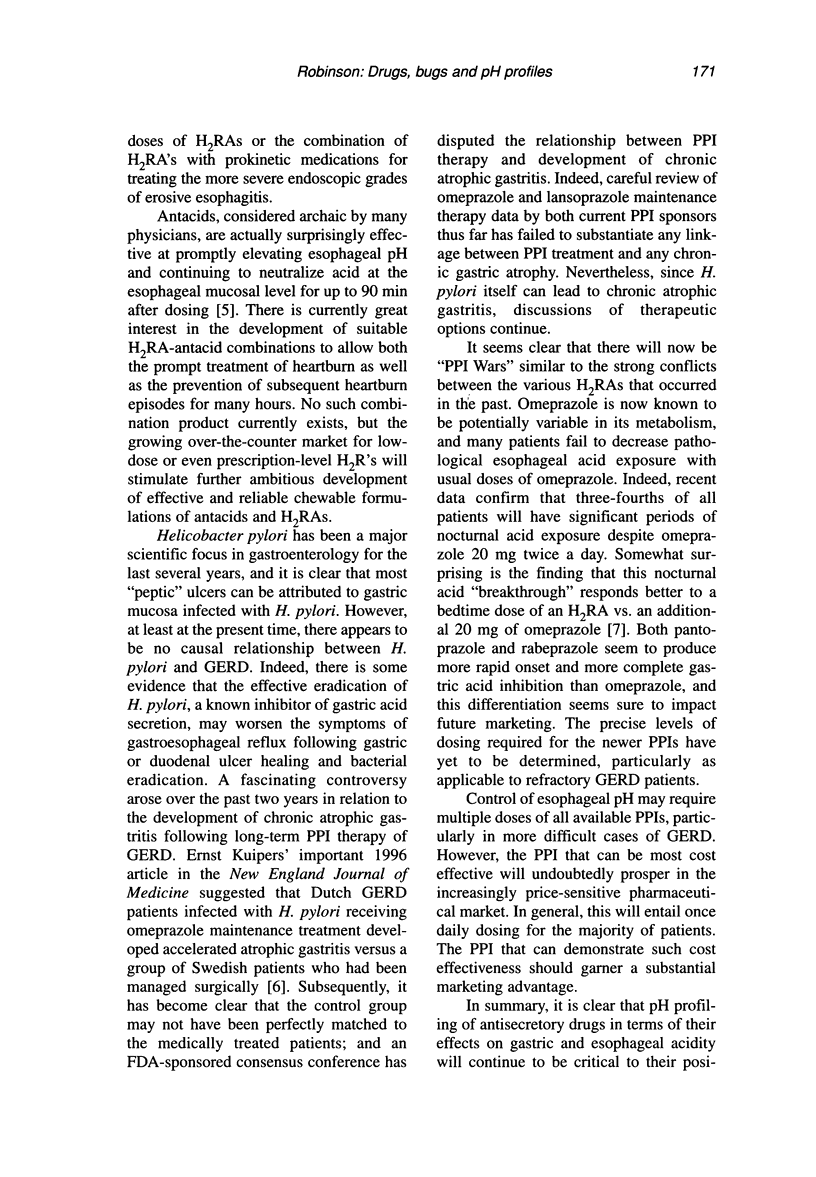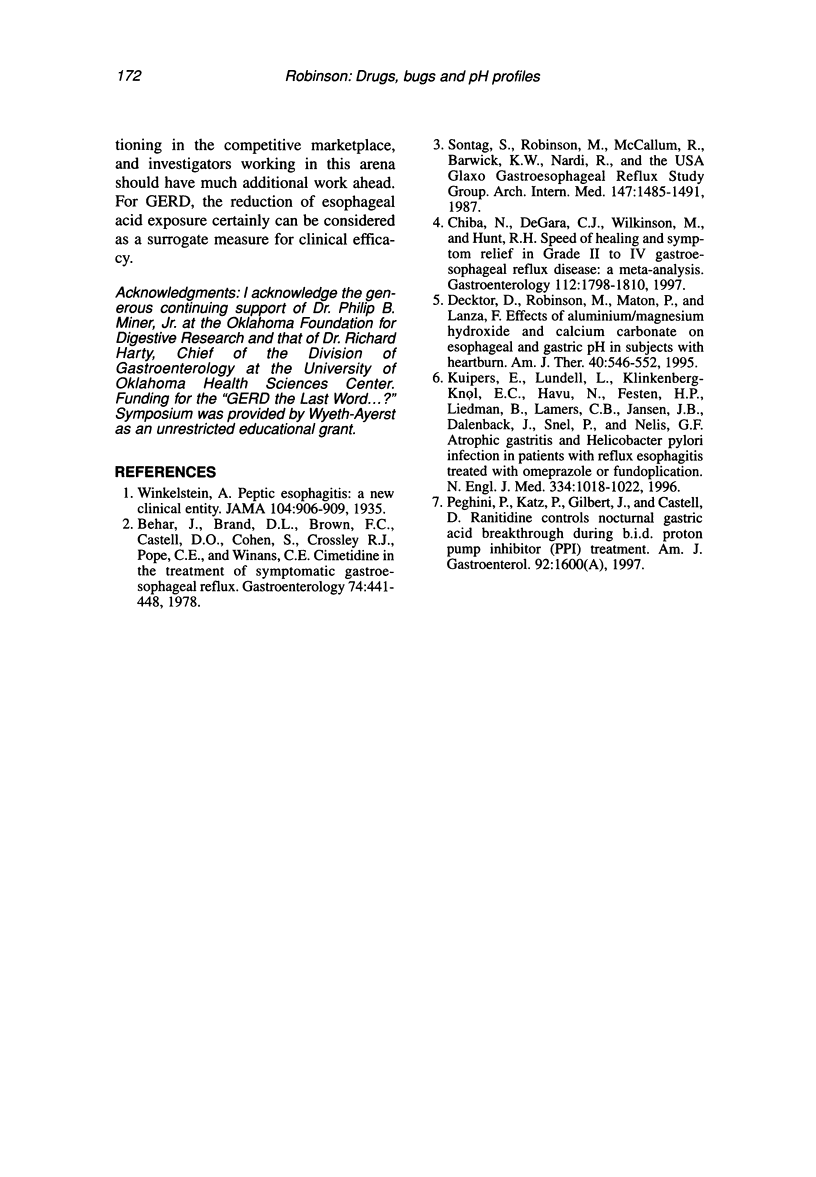Abstract
Until relatively recently, gastroesophageal reflux disease (GERD) was thought to be a relatively trivial problem, and pharmaceutical companies initially had remarkably little interest in clinical trials for GERD. Over the last ten years, GERD therapy has become the subject of intense interest, since reflux disease is now recognized as a major market for antisecretory and prokinetic drugs. Even low-technology antacids are now known to effectively neutralize esophageal acid prevent acid reflux for up to 90 minutes. Esophageal pH profiling is known to be an excellent surrogate for clinical efficacy of GERD drugs, particularly in erosive esophagitis. Years ago, famotidine normalized esophageal mucosal exposure to pH < 4.0 only when administered in doses of 40 mg twice a day. Subsequent studies confirmed that multiple daily dosing of histamine-2 receptor antagonists (H2RAs) was mandatory for GERD treatment, with clear dose-response relationships for each agent. Proton pump inhibitors (PPIs) have each been carefully assessed in terms esophageal and gastric pH profiles. Omeprazole has a particularly flat dose response curve, making it difficult to differentiate pH or clinical effects of 20 vs. 40 mg doses. Improved rapidity of onset and/or enhanced potency is demonstrable in pH data obtained with lansoprazole, rabeprazole and pantoprazole. Such differences will translate to improved clinical efficacy, based on the meta-analyses of Richard Hunt and his group in Canada that correlate pH effects and symptom relief/healing. PPI's have dependably surpassed H2RAs and prokinetic drugs in management of the more severe grades of esophagitis. Helicobacter pylori has a peculiar relationship to GERD. There has been some concern that PPIs given to patients with H. pylori might accelerate development of severe atrophic gastritis. It is also now known that eradication of H. pylori may increase symptomatic GERD (possibly as a result of increased gastric acid secretion once the bacteria have been eliminated). New data confirm nocturnal breakthrough of acid secretion and esophageal acid exposure in three-fourths of patients on omeprazole 20 mg twice daily. This nocturnal acidity can be controlled more effectively with a nighttime dose of an H2RA than with a third dose of omeprazole. Control of acid secretion and improved gastric and esophageal pH profiles are goals of modern GERD therapy, and the product that most cost effectively normalizes esophageal acid exposure will have a substantial advantage in the ever-growing GERD marketplace.
Full text
PDF



Selected References
These references are in PubMed. This may not be the complete list of references from this article.
- Behar J., Brand D. L., Brown F. C., Castell D. O., Cohen S., Crossley R. J., Pope C. E., 2nd, Winans C. S. Cimetidine in the treatment of symptomatic gastroesophageal reflux: a double blind controlled trial. Gastroenterology. 1978 Feb;74(2 Pt 2):441–448. [PubMed] [Google Scholar]
- Chiba N., De Gara C. J., Wilkinson J. M., Hunt R. H. Speed of healing and symptom relief in grade II to IV gastroesophageal reflux disease: a meta-analysis. Gastroenterology. 1997 Jun;112(6):1798–1810. doi: 10.1053/gast.1997.v112.pm9178669. [DOI] [PubMed] [Google Scholar]
- Decktor Dennis L., Robinson Malcolm, Maton Paul N., Lanza Frank L., Gottlieb Stanley. Effects of Aluminum/Magnesium Hydroxide and Calcium Carbonate on Esophageal and Gastric pH in Subjects with Heartburn. Am J Ther. 1995 Aug;2(8):546–552. doi: 10.1097/00045391-199508000-00006. [DOI] [PubMed] [Google Scholar]
- Kuipers E. J., Lundell L., Klinkenberg-Knol E. C., Havu N., Festen H. P., Liedman B., Lamers C. B., Jansen J. B., Dalenback J., Snel P. Atrophic gastritis and Helicobacter pylori infection in patients with reflux esophagitis treated with omeprazole or fundoplication. N Engl J Med. 1996 Apr 18;334(16):1018–1022. doi: 10.1056/NEJM199604183341603. [DOI] [PubMed] [Google Scholar]
- Sontag S., Robinson M., McCallum R. W., Barwick K. W., Nardi R. Ranitidine therapy for gastroesophageal reflux disease. Results of a large double-blind trial. Arch Intern Med. 1987 Aug;147(8):1485–1491. [PubMed] [Google Scholar]


